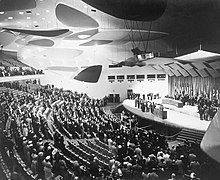Aula Magna (Central University of Venezuela)
As well as choosing the location near Central Caracas, the committee also recommended basing the plan for the campus on similar models, including Leopold Rother's "urban project" at the recently opened National University of Colombia in Bogotá.[5] In keeping with the theme of the project, Villanueva's designs include unconventional features that reflect the artistic nature, such as describing buildings not as objects but as "movements" (of which the Aula Magna is IV).[6] The contract for the construction of the Aula Magna was given to the company Christiani & Nielsen, starting on November 28, 1952, and with its end date set as March 31, 1953;[7][8] that is, the work had to be completed in only 4 months.[2][9] These structures were installed on the ceiling under the supervision of the American firm Bolt, Beranek and Newman, and adjusted while an orchestra played on stage to calibrate the acoustics and make sure the quality remained consistent throughout the hall.Calder was working on a structure for outside in the Plaza Cubierta; when he became aware of how complex the project was, he suggested integrating his panels into the space of the room with "an artistic, decorative and acoustic purpose".[1] This was a fortunate idea, because at the same time as Calder's suggestion, the American company was viewing the hall's original designs, and noted that the shape of the structure would detrimentally affect the acoustics unless it had extensive panelling.[12] In terms of artistic qualities, the art critic Phyllis Tuchman noted that the clouds are "colorfully curving and thus archetypically 'Latin American'" but were designed by one of the few non-Latin Americans working on the project, making them "paradoxical" but still "expressing the region's 'lyricism'", as well as "resembl[ing] clouds scattered across a night sky [...] [w]ith the hall darkened" and making those who "[enter] the auditorium when it's illuminated by houselights [...] able to feel as if they have entered a multihued, three-dimensional abstract painting".[18] The critics Helen Gyger and Patricio del Real write that "the Aula Magna's interior [...] represents the high-point of Villanueva's interest in the synthesis of the arts".They are made from the wool of either Chilean or Australian sheep (sources contradict) and were woven in England with a stitched furrow, have leather arms, and have seat cushions that automatically retract and are perforated on the bottom.[13] The architectural style of the Aula Magna is inspired by the classic Greco-Roman theatre, with a 1/4-circle structure and a fan-shaped ceiling, designed like an amphitheater or conch shell.This creates some incongruous features of the hall, including that the doors that are suspended on the sides of the stage would have been raised by hydraulic jacks, and that the space that today is the basement Art Gallery was intended to be a bar area and contain large bathrooms for the audience.[1][9][7] The Aula Magna is within an intricate system of walkways, being part of the Plaza Cubierta and connected to other buildings in the central complex (the University President's office, the Sala de Conciertos, and the library), each by several distinct routes.[4] It was in the hall, during its inauguration at the Inter-American Conference it hosted, that "three thousand leaders and delegates" of the Americas signed a historical resolution declaring Communism a threat to world peace.[30] One of the company's productions of Jesus Christ Superstar in the hall, on March 7, 2010, was attacked as a political campaign of intimidation against the group by masked assailants with tear gas before the show, harming the actors.[4] UNESCO had several concerns about the preservation of the hall, as well as the rest of the campus, due to the growing number of students, the age of the mosaics and concrete, and the area being "vulnerable to social unrest".[35] UNESCO's fears were subsequently realized; during a protest in July 2013 a bus was set on fire within the square outside the hall and damaged one of the adjacent murals, an iconic piece by Venezuelan Oswaldo Vigas.[35] However, it has been said by the Financial Times that restricted funds are a greater threat to the preservation of the hall and artworks, both from the economic downturn due to the Crisis in Bolivarian Venezuela and from the Chávez and then Maduro governments defunding universities and not prioritizing independent culture.








UNESCO World Heritage SiteLocationUniversity City of CaracasCaracasVenezuelaSessionCoordinatesCentral University of VenezuelaCarlos Raúl VillanuevaChristiani & Nielsenacoustic'clouds'Trina MedinaLeopold RotherNational University of ColombiaBogotáModernistMarcos Pérez JiménezInter-American ConferenceAlexander CalderFloating Clouds (artwork)Floating CloudsLeo BeranekBolt, Beranek and NewmanorchestrafiberglassPhyllis TuchmanUNESCOcashmere woolincandescentfluorescentStrand Lightinglighting control consoleUS Embassy in Caracasamphitheaterconch shellLe CorbusierPalace of SovietsprosceniumMuseum of Modern ArtPastor de NubesJean ArpMateo ManaureVictor VasarelyAntonio EstévezCommunismFidel CastroLeonard BernsteinMontserrat CaballePablo NerudaMichel HausmannHugo ChávezNicolás MaduroJesus Christ Superstartear gasRafaela Requesens2019 Venezuelan presidential crisisOswaldo VigasBanco MercantilTelefónicaFinancial TimesCrisis in Bolivarian VenezuelaUS dollarsCecilia García ArochaTeresa Carreño Cultural ComplexCentral LibraryCaracas Botanical GardenRectory PlazaTierra de nadieBy Mateo ManaureBy Francisco NarváezBerger des NuagesClock TowerConductores de VenezuelaL'AmphionMaría LionzaRáfaga de nieveCovered GymnasiumOlympic StadiumUniversity StadiumLandmarksBirthplace of Simón BolívarBolivarian MuseumBoulevard of Sabana Grande, open-air museumChildren's MuseumWilliam Phelps Ornithological MuseumContemporary Art MuseumFine Arts MuseumNational Art GalleryNational PantheonBet-El SynagogueTiféret Israel SynagogueCaracas CathedralIglesia de San FranciscoLa Chiquinquirá ChurchMosque of Sheikh Ibrahim Al-IbrahimChurch of St. Constantine and HelenaCaracas Venezuela TempleBrígido Iriarte StadiumCaracas AthenaeumEstadio OlímpicoEstadio Simón BolívarEstadio UniversitarioLa Rinconada HippodromeNational LibraryNational TheaterParque CristalPoliedro de CaracasTeatro MunicipalTeatro Simón BolívarUniversity CityMiraflores PalacePalacio de Justicia de CaracasPalacio de las AcademiasPalacio Federal LegislativoPalacio Municipal de CaracasSupreme Tribunal of JusticeYellow HousePaseo Los PróceresBoulevard of Sabana GrandeAerial TramwayAvenida BolívarCorreo de CarmelitasCentro SambilCentro San IgnacioEl Recreo Shopping Mall